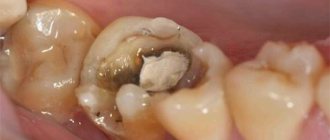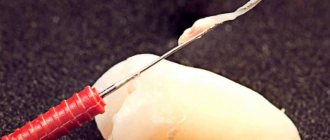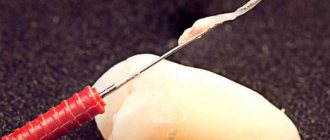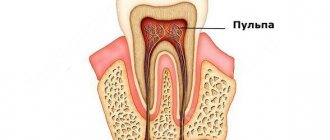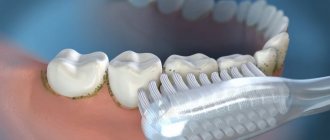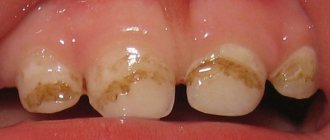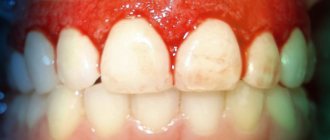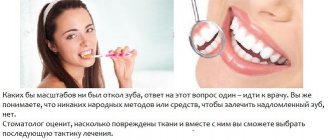Is it possible to remove tartar at home?
In the presence of dense and old deposits, effective removal of tartar at home is almost impossible. The most complex is considered to be subgingival tartar, which forms in periodontal pockets. In this case, contacting a hygienist is mandatory.
Of course, with due effort it is possible to remove the top layer of hard supragingival deposits, but its complete removal is only possible with the help of special equipment in the dental hygienist’s office. When the plaque is in the initial stage of hardening or has a loose structure, it can be quite successfully dealt with at home. It’s easier to do prevention than to deal with the consequences.
Contraindications for use and side effects
The use of soda is prohibited in the following cases:
- Acute gum diseases, such as gingivitis and periodontitis, accompanied by swelling, bleeding and redness.
- Subgingival calculus.
- Increased sensitivity of teeth.
- Crowns and dentures installed in the mouth, as well as fillings, especially on the front teeth.
- Orthodontic structures fixed to the teeth, such as braces.
- Individual intolerance to soda and other components.
The use of soda mixtures can lead to unwanted side effects:
- thinning of enamel;
- fragility and increased sensitivity of teeth;
- change in color of installed fillings and dentures;
- chemical damage to the oral mucosa.
If you experience increased tooth sensitivity or gum damage, stop using soda and consult a dentist.
How to remove tartar at home?
No matter how trivial it may sound, cleaning tartar at home is carried out with ordinary hygiene products: toothpaste, brush and irrigator.
- Toothpaste. For more or less effective removal of tartar, you need high-quality toothpaste with high abrasiveness (with an RDA coefficient of 120). Such products contain solid microparticles, most often silicon dioxide or aluminum oxide. Abrasive toothpastes do a good job of removing loose plaque and are even able to clean loose hard deposits, but at the same time they cause damage to the enamel. They are not suitable for people with sensitive teeth. This is especially true for tooth powder, which often appears in lists of tips on how to get rid of tartar at home. It should be used with extreme caution as it contains a large number of aggressive abrasive elements.
- Toothbrush. To quickly remove tartar at home, while its layer has not yet become thick, you need to use a toothbrush with the hardest bristles. This option is not suitable for everyone, since intensive cleaning causes the bristles to injure the enamel and gums. A good ultrasonic toothbrush would be ideal.
- Irrigator. A jet of water (even at high intensity) is not capable of destroying hard tartar, but it does a very good job of removing loose plaque. An irrigator is strictly recommended if you want to get rid of tartar at home, since it effectively cleans the most inaccessible areas of the oral cavity.
How to remove stone in dentistry
The best way to combat plaque and deposits is professional cleaning. Today, as part of this procedure, dental clinics offer various techniques. Let's look at them in a little more detail:
- Air Flow sandblasting is a popular technique that is based on cleaning using a water-salt solution. It is supplied under high pressure and allows you to remove hardened deposits in hard-to-reach places. The smallest particles of the mixture literally beat off plaque and pigments from the enamel surface. For some time after the procedure, teeth may remain sensitive, especially to temperature changes in food and drinks. After cleansing, it is better to limit the consumption of coloring products, coffee, tea and smoking,
The photo shows the method of brushing teeth with the Air Flow system. - ultrasonic cleaning – under the influence of an ultrasonic scaler, the stone literally breaks down, turning into powder. Thanks to the simultaneous supply of water, the remaining plaque and hard deposits are easily and quickly washed away from the surface of the teeth. The technology allows for effective cleaning of gum pockets. The procedure is often performed in combination with Air Flow and is absolutely painless for the patient. After cleaning, the enamel is polished and coated with a fluorine-containing compound to further strengthen hard tissues,
Using the Vector ultrasound device, a specialist cleans periodontal pockets
“I am a regular client of your clinic, and I decided to express my gratitude with this review. I have treated your caries several times and for several years now I have been having my teeth cleaned here with Air Flow, at least once every six months. I really like the quality of service, the work of the staff and the atmosphere in general. Thanks to the efforts of your specialists, the procedure is always quick and absolutely painless. Your smile becomes snow-white, and no whitening is necessary! Personally, for me the effect lasts all these six months, until the next cleaning. True, I don’t smoke or drink coffee, I try to take care of my health...”
Marina A.K., Moscow, fragment of a review on the website of a dental clinic
- dry cleaning – special chemical reagents are also used to effectively break down hardened contaminants. Their help is resorted to in cases where ultrasound and sandblasting are ineffective. Hydrogen peroxide and compositions with abrasive particles are used as preparations.
The photo shows chemical teeth cleaning - Hand Cleaning – Hand tools can also be used to remove pigmented areas. These are small thin hooks with which the specialist “catches” the accumulations under the gums and carefully removes them from the pockets.
The manual method uses hooks for cleaning.
Gradually, hardened deposits will begin to destroy hard tissue, which can easily lead to caries. The microabrasion procedure will help stop this process. The essence of the technology is gentle polishing of the enamel surface, which carefully removes pigmented spots and prevents further development of the pathological process.
As part of the procedure, the specialist removes a very thin layer using a special abrasive composition. The layer thickness usually does not exceed 25-70 microns, so there is no need to worry about thinning of the enamel and its increased sensitivity. In complex clinical cases, up to 200 µm is sometimes removed1. The procedure is relevant for patients who have heavily contaminated and pigmented areas when they do not respond to the above cleansing methods. Indications for its treatment also include a spotted form of hypoplasia, caries at the “white spot” stage and signs of demineralization.
Lemon, celandine and soda
On the Internet you can find many articles with headings from the series “how to clean tartar at home” or “how to dissolve tartar at home.” In these materials you can find dozens of “one hundred percent” recipes that will miraculously help get rid of tartar. In fact, all this is a myth. No traditional medicine can effectively remove hard dental plaque. Moreover, most of these tinctures and decoctions can also cause harm. For example, a decoction of celandine (often recommended) is poisonous and can cause poisoning. Lemon juice, which is a component of most of these recipes, contains acid, which is generally harmful to dental tissue and is ineffective at removing hard deposits.
To summarize, there is more harm from such recipes than good. The only more or less effective remedy, whose chemical properties help to somehow break down small dental deposits, is a solution of soda and hydrogen peroxide. At the same time, the same peroxide (especially if you make a mistake with the proportions) can cause serious harm to the enamel, so you can use it only at your own peril and risk.
Alternative Methods
Peroxide is not always effective, so there are a number of alternative recipes that enhance its effect on tartar. Let's take a closer look at how to remove tartar using hydrogen peroxide and auxiliary components.
| Auxiliary Component | How to cook? | How to use? | Duration of use |
| Soda | Take a tablespoon, put half of the baking soda in it and add 3-4 drops of peroxide to make a plastic mass | Apply a large pea-sized amount of product to your toothbrush and clean your teeth thoroughly, paying special attention to chewing teeth. | 2 times a month |
| Oak bark | Grind 1 tablespoon of oak bark in a coffee grinder to a powder. Add a few drops of peroxide to make a thick paste | Apply the product to your toothbrush and go over all your teeth. This composition is especially good for gums, as it helps strengthen and destroy pathogenic flora. | 2-3 times a week, preferably at night |
| Sage and lemon | Grind a teaspoon of sage herb in a coffee grinder, add 5 drops of lemon juice and the same amount of peroxide | Apply the product to a cotton swab and apply it to your teeth, press lightly and hold for 3 minutes, then rinse your mouth with warm water. | 1 time per month |
Dozens of other ways to get rid of tartar are listed in our large selection.
Using peroxide, you can remove not only stones from teeth, but also from dentures. To do this, place the removable structure in a container with peroxide for several minutes, let it stand, and then clean it well with a stiff toothbrush. If you do this procedure several times a month, the dentures will be in perfect condition.
Note! Hydrogen peroxide cannot be used to replace regular hygienic toothpaste, as it will not give the desired effect. On the contrary, there is a risk of gums softening, which will lead to increased bleeding and premature receding.
We hope that our recommendations were useful, and now you know how to remove tartar with hydrogen peroxide. The procedure, you see, is not complicated, but precautions must be observed. If you doubt the effectiveness of the method, it is better to consult a specialist before using it. Perhaps peroxide specifically in your case will do more harm than good, and the stone will be removed using other methods.
Tags: at home, tartar, folk remedies, hydrogen peroxide, step-by-step instructions
About the author: DrZubastik
- Related Posts
- How to remove bad breath at home?
- A simple and effective way to whiten teeth using strawberries
- How to whiten teeth with soda at home without harming the enamel?
« Previous entry
Prevention of tartar
This article is entirely devoted to how to remove tartar at home, but it is also important to talk about how to prevent its occurrence. Prevention of dental plaque includes comprehensive and regular oral hygiene. Tartar builds up in hard-to-reach places, so use floss, irrigators and mouth rinses if you want to minimize the risk of plaque mineralization. Another important point is nutrition. Foods high in carbohydrates and dyes accelerate the formation of tartar. The same applies to tobacco: do you want to have healthy and snow-white teeth? Stop smoking. Well, if you do notice the first signs of tartar formation, consult a doctor. Professional cleaning and saturation of the enamel with useful minerals will restore your snow-white smile.
Subtleties of use
The amount of mixture used, as well as the frequency of use, will depend on its components. Typically, a pea-sized amount of paste is used to brush your teeth.
Regularity. Some formulations can be used every day, more aggressive ones - no more than 1-2 times a month.
The use of soda may result in thinning of the enamel, as well as deterioration in the mineralization of teeth, which can lead to an increase in their fragility. Therefore, during the treatment period you should:
- use toothpaste with a high content of calcium and fluoride;
- increase the amount of dairy products in the diet (an additional source of calcium).
Preventive measures
Simple rules to prevent the appearance of tartar:
- Thorough brushing of teeth 2 times a day. In this case, the toothbrush should have medium-hard or hard bristles (for gum inflammation - soft).
- From time to time you can use special toothpastes with increased abrasiveness. But no more than 1 month and no more than 3-4 times a year. The most popular: Lacalut brilliant, Colgate “Professional Cleaning”, President White, SPLAt Professional “Whitening Plus”, Blendamed 3D White.
- Mandatory use of mouthwash after main meals.
- Use dental floss after brushing your teeth and throughout the day as needed.
- Limit the consumption of strong coffee and tea.
- Mandatory inclusion of solid vegetables and fruits in the daily diet.
- Visit your dentist at least once a year for an examination and professional cleaning.
Reference. Toothpicks do not replace dental floss and can severely injure the gums, so they are not recommended for use.
